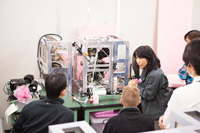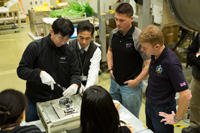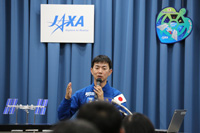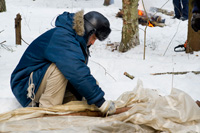Astronaut Kimiya Yui’s training at the Tsukuba Space Center for a long-duration ISS mission
Astronaut Kimiya Yui, a crew member for the International Space Station (ISS) Expedition 44/45 mission, returned to Japan in early January to train at the Tsukuba Space Center (TKSC) on the Japanese Experiment Module “Kibo” and the H-II Transfer Vehicle “KOUNOTORI” from January 7-15.

Yui and ESA astronaut Timothy Peake are lectured about Japan’s new experimental hardware, Electrostatic Levitation Furnace (ELF) (Credit: JAXA)

Yui (left), NASA astronaut Kjell Lindgren (back), and Peake (right) are lectured about ELF (Credit: JAXA)

Press conference (Credit: JAXA)
He brushed up on the critical systems of Kibo, including Command and Data Handling (C&DH), Electrical Power System (EPS), Communication and Tracking (C&T) system, the Thermal Control System (TCS), and the Environmental Control and Life Support System (ECLSS). He refreshed his knowledge and skills to properly respond to irregularities that might affect these systems.
He also confirmed daily operations conducted on Kibo and the procedure of hardware maintenance he would service during his mission. Yui also underwent robotic arm (Japanese Experiment Module Remote Manipulator System: JEMRMS) manipulation training and simulated the relocation of an exposed facility payload via the simulator. Yui also simulated Kibo’s airlock operations alongside the JAXA Flight Control Team (JFCT), which strengthened their teamwork. Training for the experiments to be performed on Kibo included onboard operations installed in the payload racks and handling of each chamber containing experimental samples.
Training for KOUNOTORI included onboard crew tasks as well as the mission flow and response to contingency cases.
As this was the last opportunity for Yui to visit Japan before the start of his 44/45 Expedition mission, Yui, JFCT, and experiment staff finalized their adjustment. On January 5, a press conference was held at the JAXA Tokyo office to discuss Yui’s ISS mission where he expressed his aspirations for the mission to the media.
Having completed training in Japan, Yui moved to the U.S. in mid-January and trained at the NASA JSC.
At the JSC, Yui and his Expedition 44 crewmates confirmed procedures in the event of an emergency such as fire, etc. in the ISS mockup (a full-scale training facility). As part of medical training, cardiopulmonary resuscitation was executed using an Automated External Defibrillator (AED). In addition, Yui underwent a series of training covering the Space Station Remote Manipulator System (SSRMS) manipulation for a visiting vehicle, repair of toilet failure, and support of Extravehicular Activity (EVA) preparation.

